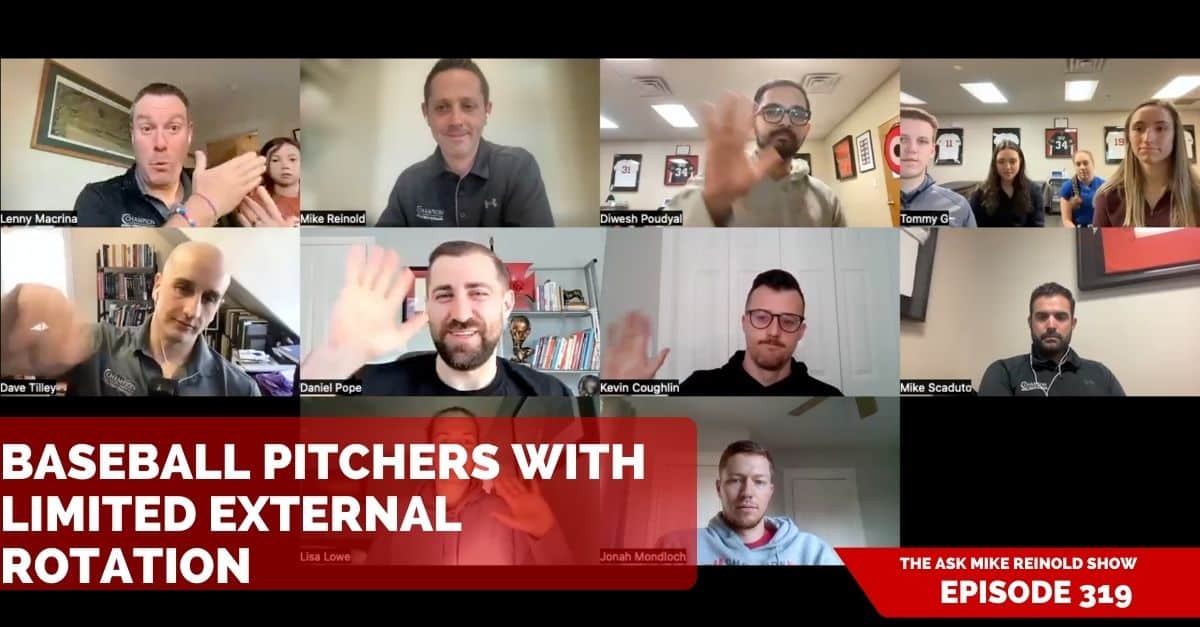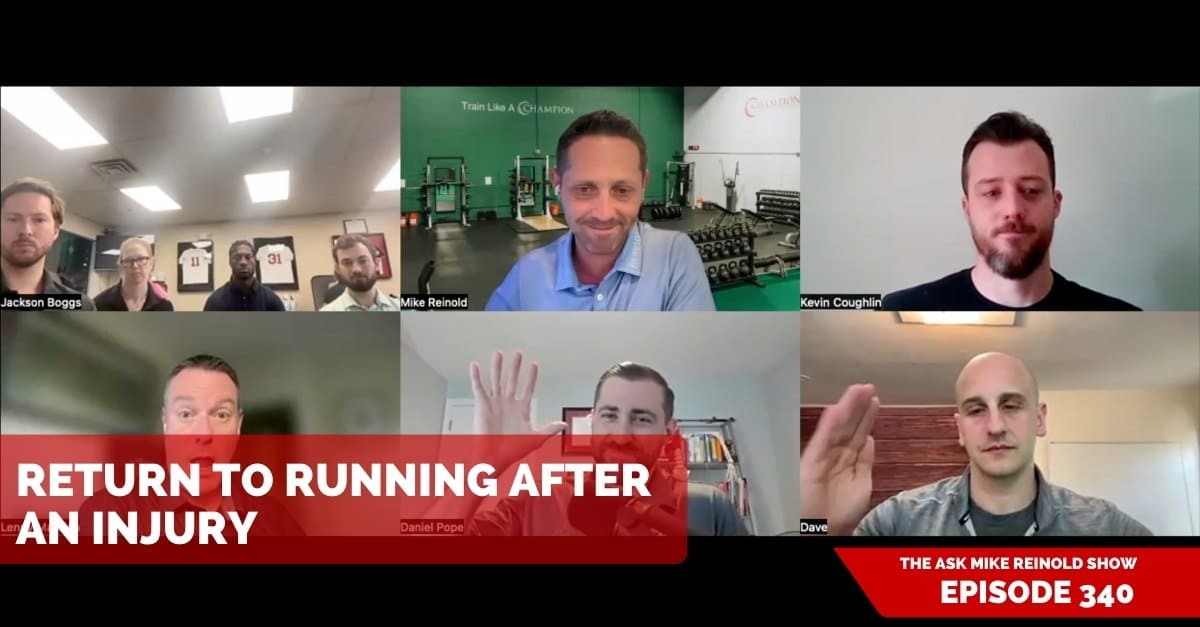We treat a lot of baseball players at Champion. And one thing is certain, throwing a baseball sure does make a lot of people lose shoulder mobility!
We often see this correlated with medial elbow pain, so when someone is rehabbing an elbow injury like Tommy John, we often focus as much on the shoulder as the elbow.
We talk about this concept and more in this episode.
To view more episodes, subscribe, and ask your questions, go to mikereinold.com/askmikereinold.
#AskMikeReinold Episode 319: Baseball Pitchers with Limited External Rotation
Listen and Subscribe to Podcast
You can use the player below to listen to the podcast or subscribe. If you are enjoying the podcast, PLEASE click here to leave us a review in iTunes, it will really mean a lot to us. THANKS!
Show Notes
• Teres Major: An Important Muscle that is Often Overlooked in Throwers
Transcript
Courtney:
All right. Sam from California. “Hello, I am working with a left-handed pitcher who had ulnar nerve transposition status post one year. He has been doing well and is ready to pitch for his upcoming season. For a pitcher, he has very limited shoulder external rotation. He has normal range of motion throughout the rest of his body. He does have restricted shoulder flexion, which has improved. He continues to have intermittent medial elbow pain and minimal ulnar nerve symptoms. So my question is, is his lack of shoulder external rotation contributing to excessive elbow valgus during his delivery and increasing tension at the elbow? And should we try to increase his glenohumeral external rotation as this may have been the root cause of his elbow pain to begin with? Thank you.”
Mike Reinold:
Great job. That was a long question, so you nailed that. That was amazing.
Dave Tilley:
It kept going.
Mike Reinold:
Good job.
Lenny Macrina:
One breath.
Mike Reinold:
Right? That was amazing. When I read that question from Sam, I was like wow. Did you just describe every one of my patients for the last five years? To the T, so much. All right, who wants to start this off? So ulnar nerve transposition, still having symptoms a year later, has no external rotation. Could that be part of the reason? I don’t know. Mike, you want to start this off? I feel like you’re seeing a bunch of these lately too. What are your thoughts?
Mike Scaduto:
Yeah, sure. I think this is definitely a pretty common presentation for our patients at Champion. I would say that shoulder range of motion could certainly play a role in stress at the elbow. We know that when baseball players throw, they get tight and they get tired. When they get tight, they tend to lose overhead elevation, maybe some soft tissue restriction in the Latin teres major that could also potentially be a cause for limited external rotation, and that you need to make up motion somewhere. So maybe they’re trying to throw as hard as they can and they’re gapping a little bit more at the medial elbow. Just putting a little more strain on the UCL, a little more stress on the UCL. It sounds like potentially they had a UCL sprain if they’re having medial elbow pain and they did an ulnar nerve transposition where they moved the nerve, but maybe we never addressed the UCL during surgical time. So sounds like maybe they’re still dealing with a UCL sprain to be honest.
Mike Reinold:
I wonder if maybe they just thought it would heal up during. It was like a mild sprain but the nerve was subluxing or something like that and it would heal up. But yeah, that makes sense. I like how you mentioned there, Mike, that you have to pick up the motion somewhere else. In order to throw a ball, you need to get into lay back. So I thought that was a really good point, is if you have limited external rotation, you’re probably going to torque more at the medial elbow to try to get more and more motion. So I think that that makes sense. Len, obviously I think you see a ton of these too. What are your thoughts?
Lenny Macrina:
It’s pretty interesting to see a lefty come in because you’ll stretch their left side out, which is their throwing side, and then you stretch their right side out and you’re like, “Huh, you should probably be a righty thrower because you have better motion on the right side than the left.” We always make that joke, but it’s kind of true. They all started throwing when they were younger, so they should get that lay back and that retro that they need to get external rotation. But I don’t know what it is on lefties. It seems like all of us are righties by nature. Righty by nature, not because I hate you. Righties by nature, sorry. They just developed left-handed, but the gain and external rotation is inadequate and they end up breaking down, whether it’s capsular stuff or elbow stuff. They just don’t have that lay back.
This situation and the loss of flexion… We know that loss of flexion increased their risk for elbow injuries as well. Whether or not that was secondary or primary, who knows? But throwing will make you lose some flexion as well. If that’s not restored, that has a higher risk of getting elbow pain as well. Camp showed that and we showed that probably, I guess it’s going on a decade now, which is scary. I think it’s something to address and like Mike said, I think there’s an underlying UCL issue that probably will need to be addressed down the road. Gaining external rotation, to answer your question, is going to be tough. These guys, you can maybe gain a little with soft tissue and stretching them out, but it’s probably a very firm end field and those firm end fields don’t gain a lot of motion. It sometimes is what it is with those lefties, which is you stretch them out and you’re like … And it’s hitting a wall. Versus the righties, it’s just a nice bounce into entering. So it’s going to be a tricky one, but I think we’re probably going down a road of more surgery.
Mike Reinold:
Wow. To me, I think you nailed it. I think one thing that people don’t appreciate if you don’t treat a lot of baseball players is that lefties do look different and you should not expect lefties and righties to be the same. So that’s a really good point. I wish more published studies delineated lefties and righties out, but just the end, the amount of subjects in studies that are lefties are small. So it’s hard to delineate them out, but they surely are different. I don’t know if that’s glenoid orientation, scapular orientation, thorax orientation, but there’s certainly something a part of it. I’m going to provide a little more optimism than Len. I think actually Len is spot on, but a little more optimism. Just because the shoulder flexion is so bad and I think we’ve all seen in our hands at Champion every day, if we do soft tissue work on lat teres or even subscap, they can gain 10, 20 degrees of external rotation in a treatment session. Just by desensitizing that, trying to redo some tone, get that mobility going, and then I think that takes an enormous amount of strain off the medial elbow.
The students know we did that this week. A few of you made measurements for me because I kept measuring this guy 10 times each session just to keep documenting his mobility. So I actually like that you had that loss of shoulder flexion. To me, that shows me the lat teres major, probably maybe even some subscap, has some tightness and I think there’s some optimism. But you’re right. If you’re still having ulnar nerve symptoms like Lenny said, you’re still having medial elbow pain, there might even be something else going on.
But I always like to say this. I think it’s unfair right now to say what we should do for this person because they have that limited range of motion. So I think our first goal would be, is let’s maximize that range of motion, get his overhead flexion back, see if that increases his lay back and then see if that takes that stress off the medial elbow. If it does, boom, you’re good. If it doesn’t, like Lenny said, we may have to address more that’s going on. But Sam, I think you did a really good job putting that all together and that’s some next level thought process. So kudos to you for that, I thought that was really good. Hopefully, focus on some of those things we talked about, but I don’t know. I think we nailed that episode. Anybody have anything else they want to add or… I feel like we got done quick.
Lenny Macrina:
I think it’s going to be ramping up an adequate throwing program for him too. A lot of times it’s like let’s just wing it and just have him start flinging the ball around, so you got to ramp that up. Then also mechanically, what do they look like when they throw? Are they just opening up really early, slinging it, and don’t have good mechanics? So many other things, Sam, you can look at too. But I pulled up some old data, this is unpublished data, which is shocking to me. That’s probably why we didn’t publish it. We had 220 right-handed pitches and only 76 left-handed. So you can see doing these studies, this was on Tampa Bay Rays pitches over a period of time, we found no difference. I’m shocked. 131 versus 130 of external. These are professional baseball players at 90 degrees of abduction. Their total motion was 183, their symmetrical internal rotation as well; the way we measured, Kevin and I, during spring training. So I was shocked when I just pulled this up that we didn’t publish it and it’s sitting in a file to publish. But 220 righties and 76 lefties. So again, the ends are off, but I was surprised that lefties have so much data. Again, these are major league baseball, so they made it to their pro career and maybe that’s the difference. They have the motion I guess in there.
Mike Reinold:
Well said, maybe they just filtered themselves out. I do think that’s part of it, but I also wonder if the standard deviations are different though. I bet you the righties have a bigger standard deviation.
Lenny Macrina:
They’re 9.6 righty versus 9.2 lefty, so minimally different.
Mike Reinold:
Wow, that’s great.
Lenny Macrina:
I know.
Mike Reinold:
Interesting. I think you’re right. I wonder if that’s selective. If you made it to the bigs, it’s because you had good range of motion. That’s super interesting. So I would say Sam, too, maybe to answer one other part of your question about “should you work on external rotation?” Like Lenny said there, you got to do your measurement. So measure internal and external rotation on both sides, calculate total range by putting them together, and you’ll see. If total range is the same, then you probably know that they’ve maximized their range of motion. But my guess is on this person, just from the experience of all the people we see with tight shoulder flexion and tight ER, my guess is it’s they’re going to have a decrease in total range of motion and it’s probably going to be from external rotation.
So take a step back, we never focus on the capsule first. These people, if shoulder flexion is limited, to me that’s almost always a lat teres, a little subscap, work on those three, get that motion back, and give that ligament some room to breathe when you throw and hopefully, that will do the trick. But if you don’t restore that and you just start a throwing program and you’re trying to throw through it, it’s like you’re just banging your head against the wall, right? You still have that thorn in your side. So make sure you work on that. Great stuff, great research analysis by Lenny. I feel like Lenny is our Lou with the ARCOS data on the Hack Out podcast now. Lou Stagner.
With the stroke game. Sorry. Anyway, if you know, you know. But anyway, I appreciate the question, Sam. If you have a question like that, please head to mikereinold.com, click on that podcast link and you can ask away and we will see you on the next episode. Thanks so much.





